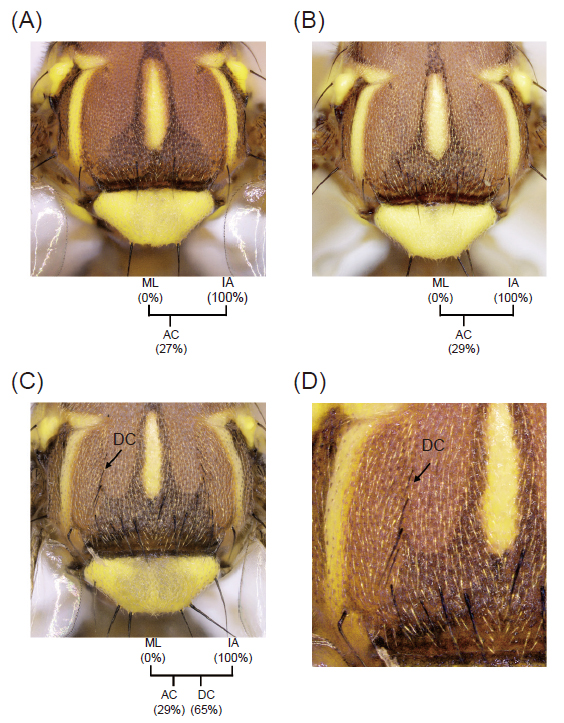All issues

Author:Yun Cheng, Dong-Hong Wu, Zu-Hsien Wang, Yu-Bing Huang,*, Ming-Yao Chiang, Hsiu-Ying Lu, and Chung-Min Yang
Abstract:
The melon fly, Zeugodacus cucurbitae (Coquilett), does not possess the dorsocentral (DC) bristles. In a selected DC (+)-line, two rows of 4–6 median size macrochaetes appeared in the dorsocentral domain of scutum and it is interesting to explore its morphological identity and genetic origin. In morphology, these DC (+) bristles fit into the dorsocentral domains of Diptera chaetotaxy ground plan and those of model insect species, Drosophila melanogaster and Ceratitis capitata. In genetics, by crossing wild type to DC (+)-line, the majority of F1 progeny were DC (–) phenotype or wild type. Segregation pattern of DC (+) and DC (–) phenotypes in the F2 progeny fit a 1 : 3 inheritance pattern, with DC (–) phenotype being dominant. The backcross of F1 to the DC (+)-line produced a 1 : 1 ratio in respect to DC (+) and DC (–) phenotypes, while F1 backcross to wild type produced most DC (–) progeny, confirming that DC (+) bristle was suppressed by a single dominant gene. The gene was given the symbol DCm for DorsoCentral bristles masked. The DC (+) bristle was stereotype patterned instead of randomly expressed, hence the atavistic origin is preferred.
Key words: Dorsocentral bristles, Melon fly, Atavistic origin
Download:![]() PDF Links
PDF Links
- 1. Using Digital Soil Mapping to Predict Soil Organic Carbon Stocks in Zhuoshui River Basin
- 2. Taxonomic Review of the Genus Asiophrida Medvedev, 1999 in Taiwan (Insecta: Coleoptera: Chrysomelidae: Galerucinae: Alticini), with Notes on Biology
- 3. Development of a Technique for Forecasting (or Pre-Detection) Anthracnose Disease Incidences of Green Mature Bagging Mango Fruits
 Submit your manuscript
Submit your manuscript
 Guide for authors
Guide for authors